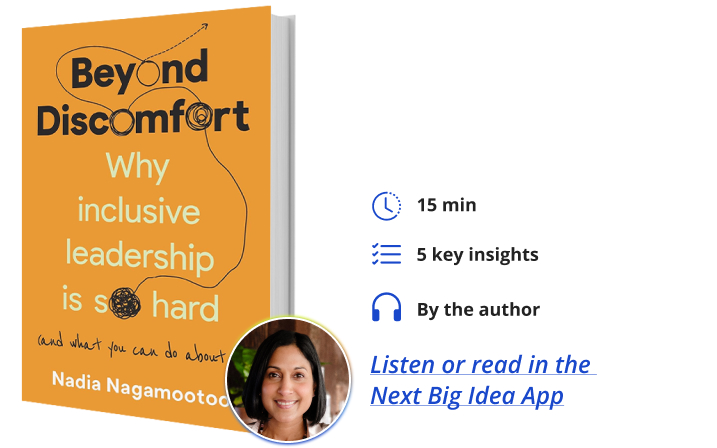Nadia Nagamootoo is a chartered business psychologist, coach, podcast host, and Founder and Chief Executive of Avenir, a globally operating Diversity, Equity & Inclusion (or DEI) consultancy. In 2023, she was listed as an HR Most Influential Thinker and awarded HR Champion of the Year at the European Diversity Awards.
Below, Nadia shares five key insights from her new book, Beyond Discomfort: Why Inclusive Leadership Is So Hard. Listen to the audio version—read by Nadia herself—in the Next Big Idea App.

1. Understanding our way of being is crucial for inclusive leadership.
For those who have been for an eye test, you’ll be familiar with that moment when the optometrist pops a strange pair of glasses on you and starts slotting in different lenses to try and find your optimal sight. Well, imagine each lens they add reflects one of the systems you belong to—past and present—in your life.
This could be your family system, educational institutes, clubs you belonged to, organizations you worked for, etc. Other lenses represent your lived experiences, behavior, and beliefs instilled in you by important people in your life and messages you received via movies and books you read. All this is the foundation of your Way of Being and, in turn, influences how you interact with the world. Your Way of Being influences what you say and do, what you see as true, and how the world responds to you. Your Way of Being isn’t fixed and can change depending on context and your openness to new thoughts and ideas.
When it comes to organizational DEI work, a leader’s Way of Being (their values, beliefs, and reality) guides our receptiveness to learn about ourselves and other people’s reality, about history and cultures different from our own. It also guides our willingness to act, for example, dismantling inequities and challenging ourselves and our colleagues to promote inclusion. The key to inclusive leadership is being open to self-reflection, truly looking deeply at oneself, why we think what we think, why DEI might evoke certain emotions in us, and where this comes from. This is far from easy.
2. When the pendulum feels like it has swung too far in the opposite direction.
DEI work can seem unfair. It can make those with majority characteristics feel less valued, criticized, and sometimes even attacked for things they have no control over—their skin color, gender, the family they were born into, and so on. On top of that, they may also feel under pressure to demonstrate allyship and that they are pro-inclusion. This goes hand-in-hand with a deep concern that anyone who identifies with majority-group characteristics is being actively overlooked for jobs or discriminated against because of quotas or positive action.
In a workshop I facilitated, a white female leader explained: “I fear that the pendulum might have swung the other way now. I mean, I’m a momma-bear of three blue-eyed, blonde-haired white boys, and I want to protect them. If we put more effort into minorities, I mean, would it put us in a better place? It’s not what’s on the outside but what’s between the ears.”
“You may discover that colleagues you have sat next to for years don’t necessarily experience the organization as you do.”
This illustrates a leader with a disconcerted Way of Being who believes in a meritocratic system where individuals are rewarded and achieve success based on talent. They also believe that fairness exists when everyone is treated exactly the same way. But, this assumes that the world operates according to this principle, and we know through a multitude of examples, that this isn’t the case. Underpinning this can be a fear of acknowledging that they are part of a system that has offered them an unearned advantage because of who they are. This is hugely uncomfortable to process and makes a disconcerted leader less receptive to learning about DEI. It also can make them less willing to act.
The key here is motivation—we have to want to understand ourselves better, our default response, and most importantly, we have to want to shift out of it and see alternative perspectives. If you notice elements of a disconcerted Way of Being in yourself, leverage your curiosity and find opportunities for group learning. Whether it’s a group coaching circle or in a cohort of leaders attending an inclusive leadership program, open yourself to conversations where you can hear other people’s experiences. In doing so, you may discover that colleagues you have sat next to for years don’t necessarily experience the organization as you do. This is a helpful way of building your receptiveness to learn about yourself and DEI.
3. When we anchor the truth in what we can see.
Imagine a white manager who believes that a Black member of their team is underperforming. They offer feedback to the Black colleague, who responds by saying she feels discriminated against because of her race. The white manager is confident that they would deal with underperformance in the same way, regardless of the individual’s background. It is clear to them, and they are unquestioning of themselves. It is, of course, absolutely possible that they would manage the situation similarly if it had been a White colleague. But is it also possible that they were unconsciously acting on stereotypes and bias, which means they are quicker to question their Black colleague’s competence? The challenge here is this: how would they ever know?
This example highlights a leader with a proof-seeking Way of Being, who is sense-making based on their established truths and what they observe as reality. They enjoy the clarity of a binary approach—either I’m right or I’m wrong—and they require evidence before they question their thinking. This means that they are receptive to learning but can be less willing to act, particularly when there is a lack of tangible information. There is a fear of the unknown here—if we open ourselves up to recognize that multiple truths might co-exist and that there are many shades of grey between black and white, right and wrong, how can we ever be confident about anything ever again? This provokes deep discomfort and so they continue to lead based on what they see and know.
Tuning in to your inner voice is essential as an inclusive leader. Notice what it’s telling you about the people you come across in your daily life. Do this for a while, and you’ll likely notice how quick you are at drawing conclusions rather than remaining open to finding out more. We all do it. But, for most people, these assessments about what’s going on remain unchecked and are therefore taken as fact. For example, imagine you walk down a busy high street and see a Black man being stopped by the police. Your inner voice might say, “I wonder what he did?” This assessment is based on a belief that “Police only stop people for good reason.” The questions you could ask yourself are: Perhaps that might not apply to everyone? What if there is bias in the system which leads to Black people being stopped more often than other racial groups exhibiting the same types of behavior? How could I find out more about this? Humans aren’t rational beings; we are led by values and emotions. So, this practice of holding your own worldview with lightness and inviting alternative possibilities into your reality is key.
4. When we don’t want to see people’s differences.
Some leaders can question the logic and rationale behind DEI concepts. For example, they say: “If we’re trying to create inclusion where everyone feels like they belong, it doesn’t make sense to highlight people’s differences then and put them into boxes based on their diversity characteristics. People are more than the labels we place on them. Isn’t that the whole point of what we were trying to avoid?”
It’s a fair challenge. However, this approach to inclusion would only work if we started with an equitable system. Just a skim through history makes it clear that certain people have been discriminated against, oppressed, and dehumanised. That history influences today’s world and how these folks are viewed and treated. It is deeply uncomfortable to analyze history and understand the consequences of ancestral trauma. For example, it might feel uncomfortable to explore the value placed on whiteness compared to any shade of brown. But it’s vital because it allows us to understand why it’s necessary to see people’s differences.
“It is deeply uncomfortable to analyze history and understand the consequences of ancestral trauma.”
A leader with a cheerleading Way of Being really believes in creating inclusion and is willing to take action, but believes they already know all there is to know, which means they aren’t as receptive to learning. They tend to fear the complexity surrounding DEI and the psychological work needed to recognize systemic inequity. They can find themselves frozen in discomfort, not knowing how best to lead, and wondering if their leadership has been as inclusive as they had thought. This can be a real blow to their self-worth.
It’s important to remember that there is no rule book for being an inclusive leader, no quick wins, and no endpoint. It can be really tough to translate your positive intent around DEI into effective action, and this doesn’t make you a bad leader. As described in Angela Duckworth’s 2013 TED Talk, what is needed is grit—holding on to your existing motivation to progress DEI whilst accepting that your current path might not be serving your goals as you had hoped. Being able to let go of a deeply held belief system and start the marathon again, this time following a different course where you open up conversations about differences rather than ignoring them, is where grit shows through.
5. How we lead Beyond Discomfort.
Have you ever had a moment where you observed or heard something exclusionary and were hit by a stream of inner dialogue? Did that just happen? Did they mean what I thought they meant? How is the other person feeling? Should I say something? But what if I misunderstood? That would be awkward. It’s a risk—they might not take it well, and it could damage the relationship. By the time you’ve processed all that, the moment has passed, and you decide it’s best to let it lie. Underpinning this behavior is fear and a huge amount of discomfort.
A leader Beyond Discomfort is willing to challenge the system, even though there is often a lot at stake, including their own reputation and careers. They also show courage to look deeply within themselves—their values, beliefs, privileges, likes, dislikes, and emotional triggers. They tune in to their self-talk, recognize their own biases and assumptions, and challenge them when they show up.
They are open to having new conversations and receptive to learning about other people’s realities, even though they might not fully understand every aspect of what they are told. They navigate the discomfort of understanding how societies’ dark and grim history influences today’s reality and people’s chances of success. Their willingness to act equitably and inclusively means they allow themselves to be guided by what others tell them, even if it isn’t tangible or completely clear. This is a mindset shift from leaders having all the answers, to showing vulnerability by seeking alternative truths.
Leading Beyond Discomfort is leading with an open heart, being completely tuned in to your emotions, and being empathetic to the emotions of others. Even if this style of leadership comes naturally to you, in this fast-paced, always-on culture we live in, it is so easy to focus on tasks and deadlines and forget to pause solely. This pause is crucial to supporting you as an inclusive leader. You might find it in different forms, such as physical exercise, yoga, or going for a walk. Use the time to reflect on moments of discomfort when you’re experiencing an inner struggle or uncertainty related to DEI. Through reflection, you can distance yourself from your emotions and focus on what’s important to you—your values—and subsequently decide with a Beyond Discomfort Way of Being.
Remember, there is no right or wrong Way of Being, but our responsibility as leaders is to understand ourselves and continue to expand our thinking.
To listen to the audio version read by author Nadia Nagamootoo, download the Next Big Idea App today:





























